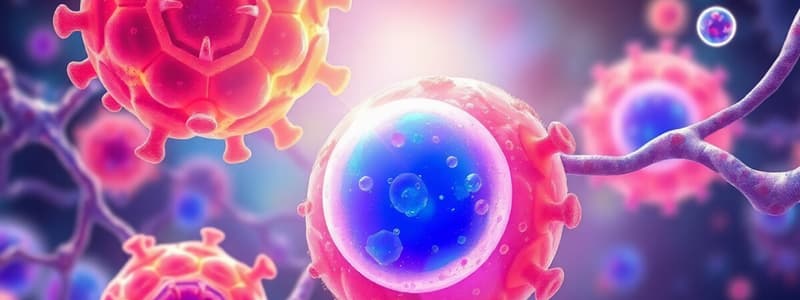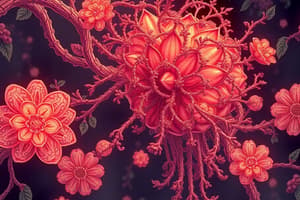Podcast
Questions and Answers
During B-cell development, which of the following processes occurs in the early pro-B cell stage?
During B-cell development, which of the following processes occurs in the early pro-B cell stage?
- Rearrangement of the V-DJ gene segments.
- Joining of $D_H$ and $J_H$ gene segments. (correct)
- Rearrangement of light-chain genes.
- Expression of the $\mu$ heavy chain.
Which of the following events marks the transition from the late pro-B cell to the pre-B cell stage in B-cell development?
Which of the following events marks the transition from the late pro-B cell to the pre-B cell stage in B-cell development?
- Expression of a functional pre-B cell receptor. (correct)
- Initiation of light chain gene rearrangement.
- Recombination of $V_H$ to $DJ_H$.
- Recombination of $D_H$ and $J_H$ gene segments.
A developing B cell fails to express a functional $\mu$ heavy chain. At which checkpoint will this cell be arrested?
A developing B cell fails to express a functional $\mu$ heavy chain. At which checkpoint will this cell be arrested?
- The transition from pro-B cell to pre-B cell. (correct)
- The transition from immature B cell to mature B cell.
- The transition from stem cell to pro-B cell.
- The transition from pre-B cell to immature B cell.
What is the role of stromal cells in B-cell development within the bone marrow?
What is the role of stromal cells in B-cell development within the bone marrow?
If a developing B cell rearranges its heavy chain genes productively on one chromosome but non-productively on the other, what is the next step in its development?
If a developing B cell rearranges its heavy chain genes productively on one chromosome but non-productively on the other, what is the next step in its development?
Which proteins bind to the $\mu$ heavy chain to form the pre-B cell receptor complex?
Which proteins bind to the $\mu$ heavy chain to form the pre-B cell receptor complex?
What is the significance of the second checkpoint in B-cell development?
What is the significance of the second checkpoint in B-cell development?
Which of the following describes the typical order of light chain rearrangement during B cell development?
Which of the following describes the typical order of light chain rearrangement during B cell development?
What is the consequence if a developing B cell fails to pass the second checkpoint in the bone marrow?
What is the consequence if a developing B cell fails to pass the second checkpoint in the bone marrow?
Which of the following proteins is essential for B-cell development beyond the pre-B-cell stage, and its deficiency leads to X-linked agammaglobulinemia?
Which of the following proteins is essential for B-cell development beyond the pre-B-cell stage, and its deficiency leads to X-linked agammaglobulinemia?
Which of the following is a characteristic of B-1 cells?
Which of the following is a characteristic of B-1 cells?
What is the primary function of RAG1 and RAG2 proteins in B-cell development?
What is the primary function of RAG1 and RAG2 proteins in B-cell development?
What is the likely outcome if a developing B cell expresses a receptor that strongly binds to a self-antigen during development in the bone marrow?
What is the likely outcome if a developing B cell expresses a receptor that strongly binds to a self-antigen during development in the bone marrow?
A researcher is studying B-cell development and notices that a particular cell population lacks surface IgD but expresses CD5. What type of B cell is the researcher most likely studying?
A researcher is studying B-cell development and notices that a particular cell population lacks surface IgD but expresses CD5. What type of B cell is the researcher most likely studying?
Which of the following describes the primary function of the pre-B-cell receptor?
Which of the following describes the primary function of the pre-B-cell receptor?
During B-cell development, at which stage does allelic exclusion ensure that only one heavy chain and one light chain are expressed?
During B-cell development, at which stage does allelic exclusion ensure that only one heavy chain and one light chain are expressed?
How do nonproductive rearrangements of immunoglobulin genes contribute to B-cell development?
How do nonproductive rearrangements of immunoglobulin genes contribute to B-cell development?
What role does the TdT enzyme play in B-cell development?
What role does the TdT enzyme play in B-cell development?
Which of the following best describes the function of PAX-5 in B-cell development?
Which of the following best describes the function of PAX-5 in B-cell development?
Which of the following best describes the heavy-chain locus in hematopoietic stem cells?
Which of the following best describes the heavy-chain locus in hematopoietic stem cells?
What is the main difference between oncogenes and proto-oncogenes with respect to B-cell tumors?
What is the main difference between oncogenes and proto-oncogenes with respect to B-cell tumors?
Which stage of B cell development has limited capactiy for self-renewal?
Which stage of B cell development has limited capactiy for self-renewal?
Which stage of B cell development marks more mature rearrangement of light-chain genes (first $\kappa$ then $\lambda$)?
Which stage of B cell development marks more mature rearrangement of light-chain genes (first $\kappa$ then $\lambda$)?
Why is negative seletion so important during B cell development?
Why is negative seletion so important during B cell development?
What is the role of positive selection during B cell development?
What is the role of positive selection during B cell development?
Which phase of B cell development is characterized by recirculation of mature B cells between lymph, blood and secondary lymphoid tissues?
Which phase of B cell development is characterized by recirculation of mature B cells between lymph, blood and secondary lymphoid tissues?
Which phase of B cell development is characterized by the generation of diverse and clonally expressed B-cell receptors in the bone marrow?
Which phase of B cell development is characterized by the generation of diverse and clonally expressed B-cell receptors in the bone marrow?
Which phase of B cell development is characterized by activation and clonal expansion of B cells by pathogen-derived antigens in secondary lymphoid tissues?
Which phase of B cell development is characterized by activation and clonal expansion of B cells by pathogen-derived antigens in secondary lymphoid tissues?
Which phase of B cell development is characterized by the differentiation to antibody-secreting plasma cells and memory B cells in secondary lymphoid tissue?
Which phase of B cell development is characterized by the differentiation to antibody-secreting plasma cells and memory B cells in secondary lymphoid tissue?
Which of the following cell types gives rise to the common lymphoid progenitor cells that can produce B and T cells?
Which of the following cell types gives rise to the common lymphoid progenitor cells that can produce B and T cells?
A pharmaceutical company aims to develop a drug that disrupts the production of B cells in the bone marrow. Which of the following factors should the drug target to prevent non-lymphoid support cells from making specific contacts with the developing B cells?
A pharmaceutical company aims to develop a drug that disrupts the production of B cells in the bone marrow. Which of the following factors should the drug target to prevent non-lymphoid support cells from making specific contacts with the developing B cells?
What proportion of of pre-B cell population makes a successful rearrangement of a light-chain gene?
What proportion of of pre-B cell population makes a successful rearrangement of a light-chain gene?
Roughly what proportion of the cells produced in the bone marrow end up producing functional immunoglobulin heavy and light chains?
Roughly what proportion of the cells produced in the bone marrow end up producing functional immunoglobulin heavy and light chains?
Translocation can be described as:
Translocation can be described as:
Flashcards
B-cell development
B-cell development
The developmental process by which B cells develop the capacity to produce antibodies.
Capacity of B cells
Capacity of B cells
The ability of B cells to produce immunoglobulins that can recognize almost any antigen.
Repertoire assembly (Phase 1)
Repertoire assembly (Phase 1)
The initial assembly of diverse B-cell receptors in the bone marrow.
Negative selection (Phase 2)
Negative selection (Phase 2)
Signup and view all the flashcards
Positive selection (Phase 3)
Positive selection (Phase 3)
Signup and view all the flashcards
Searching for infection (Phase 4)
Searching for infection (Phase 4)
Signup and view all the flashcards
Finding infection (Phase 5)
Finding infection (Phase 5)
Signup and view all the flashcards
Attacking infection (Phase 6)
Attacking infection (Phase 6)
Signup and view all the flashcards
Stromal cells
Stromal cells
Signup and view all the flashcards
Nonproductive rearrangements
Nonproductive rearrangements
Signup and view all the flashcards
Productive rearrangement
Productive rearrangement
Signup and view all the flashcards
Apoptosis
Apoptosis
Signup and view all the flashcards
Survival signal
Survival signal
Signup and view all the flashcards
Surrogate light chain
Surrogate light chain
Signup and view all the flashcards
Pre-B-cell receptor
Pre-B-cell receptor
Signup and view all the flashcards
Pre-B cell clones
Pre-B cell clones
Signup and view all the flashcards
Allelic exclusion
Allelic exclusion
Signup and view all the flashcards
Isotype exclusion
Isotype exclusion
Signup and view all the flashcards
Checkpoints
Checkpoints
Signup and view all the flashcards
X-linked agammaglobulinemia
X-linked agammaglobulinemia
Signup and view all the flashcards
Translocations
Translocations
Signup and view all the flashcards
Proto-oncogenes
Proto-oncogenes
Signup and view all the flashcards
Oncogenes
Oncogenes
Signup and view all the flashcards
B-1 cells
B-1 cells
Signup and view all the flashcards
Polyspecificity
Polyspecificity
Signup and view all the flashcards
B-2 cells
B-2 cells
Signup and view all the flashcards
B-cell Development Stages
B-cell Development Stages
Signup and view all the flashcards
Gene rearrangement
Gene rearrangement
Signup and view all the flashcards
B-cell Checkpoints
B-cell Checkpoints
Signup and view all the flashcards
Study Notes
B-Cell Development Overview
- B cells produce immunoglobulins to target almost any antigen.
- While B cells aren't stored in large quantities, they can rapidly expand when needed.
- Approximately 60 billion new B cells are produced by bone marrow daily.
- Both negative and positive selection processes are crucial in B cell development.
B-Cell Development Phases
- Phase 1: Repertoire assembly involves generating diverse B cell receptors in the bone marrow.
- Phase 2: Negative selection eliminates or inactivates B cells that react to self-antigens.
- Phase 3: Positive selection promotes immature B cells to mature in secondary lymphoid tissues.
- Phase 4: Mature B cells circulate between the lymph, blood, and secondary lymphoid tissues, searching for infection.
- Phase 5: Antigen-derived antigens activate and clonally expand B cells in secondary lymphoid tissues.
- Phase 6: B cells differentiate into antibody-secreting plasma cells and memory cells in secondary lymphoid tissue to attack infection.
- Development occurs in the bone marrow (first 3 phases), and then migrates to secondary lymphoid tissues like the lymph nodes and spleen.
B-Cell Development Stages in Bone Marrow
- B cell development in the bone marrow proceeds through several stages.
- The main function of a B cell is to produce immunoglobulin.
- Pluripotent hematopoietic stem cells produce both B and T cells from common lymphoid progenitor cells.
- Pro-B cells have restricted self-renewal capacity.
- Early pro-B cells undergo DH and JH gene segment joining.
- Late pro-B cells undergo VH segment joining to the rearranged DJH.
- The pre-B cell expresses a µ heavy chain.
- Large pre-B cells are less mature.
- Small pre-B cells are more mature and rearrange light-chain genes.
- An immature B cell is also formed.
B-Cell Development Terminology
- Early pro-B cell and late pro-B cell are stages defined by heavy chain gene rearrangement.
- Large pre-B cell and small pre-B cell are stages defined by the maturity of light chain rearrangement.
- An immature B cell expresses IgM on its surface.
The Role of Stromal Cells in B-Cell Development
- Stromal cells are microenvironments that support B cell maturation in the bone marrow.
- These are non-lymphoid supportive cells that interact with developing B cells using adhesion molecules and their ligands.
- Stromal cells produce growth factors like SCF and IL-7, which stimulate attached B cells.
- The subendosteum houses immature stem cells.
Immunoglobulin Heavy-Chain Gene Rearrangement in Pro-B Cells
- Nonproductive rearrangements don't translate to useful proteins due to random nucleotide additions.
- Productive rearrangements allow for the production of a functional immunoglobulin.
- Two copies of the heavy-chain locus exist in homologous chromosomes.
- Gene rearrangements happen in both chromosomes during B cell development to ensure a functional heavy chain.
- If both copies are nonproductive, the B cell dies in the bone marrow.
- RAG1 and RAG2 are controlled by E2A, EBF, and Pax-5.
- Survival signals indicate that B cells should survive instead of undergoing apoptosis.
Quality Control of Immunoglobulin Heavy Chains by Pre-B-Cell Receptor
- Pro-B cells need to produce a µ heavy chain that can combine with an immunoglobulin light chain to survive.
- VpreB and λ5 bind to the µ heavy chain, imitating a light chain.
- Surrogate light chains can lead to B-cell immunodeficiency if defected.
- Pre-B-cell receptors lack an antigen-binding site and are not well represented at the cell surface.
Light-Chain Loci Rearrangement in Pre-B Cells
- Large pre-B cells divide to form a clone of around 100 small resting pre-B cells that have identical heavy chains and no surrogate light chains.
- RAG proteins help with rearranging light chains (κ first, then λ).
- Approximately 85% of pre-B cells successfully rearrange a light-chain gene.
- Less than half of the B-lineage cells in the bone marrow produce functional immunoglobulin heavy and light chains.
- 2/3 have k chains, which is aided by a second isotype, which increases the success rate by 50%.
- The upper respiratory tract is mainly a chain.
Post Light-Chain Loci Rearrangement in Pre-B Cells
- IgM forms when light chain formation is successful and combines with the heavy chain.
- B-cell receptors halt the rearrangement process.
- Regulation involves allelic and isotype exclusion.
- Light chain rearrangement is independent of other small pre-B cells.
- Numerous immature B cell clones with different antigenic specificities appear.
Checkpoints B Cells Encounter During Development
- Checkpoints:
- (1st) cells need to make a heavy chain.
- (2nd) cells need to make a light chain that can bind with the heavy chain.
- First checkpoint:
- Late pro-B-cell stage (formation of a functional B-cell receptor).
- Second checkpoint:
- Small pre-B-cell stage (after light-chain gene rearrangements).
- B cells must pass both checkpoints to successfully make immunoglobulin.
Protein Expression during B-Cell Development
- Expression changes in proteins involved in rearranging the immunoglobulin genes, testing the quality of the immunoglobulin chains, and driving cellular proliferation.
- RAG-1 and RAG-2 are essential.
- TdT adds N-nucleotides.
- Pax-5 is a transcription factor that is B-cell specific.
- Btk is essential for B-cell development beyond the pre-B-cell stage.
- X-linked agammaglobulinemia is recessive.
- Patients lacking a functional Btk gene can't create circulating antibodies, which can lead to recurrent extracellular bacterial infections.
Chromosomal Translocations and B-Cell Tumors
- Mutations that convert B cells into tumor cells can arise from cutting, splicing, and mutating immunoglobulin genes.
- Translocations involve the fusion of a part of one chromosome with another.
- Proto-oncogenes are genes that cause cancer when their function or expression is perturbed.
- Oncogenes are viral genes that can cause transformation.
B-1 vs B-2 Cells
- B-1 cells produce low-affinity antibodies that bind to various antigens (polyspecificity).
- They typically have little or no surface IgD.
- CD5 is present.
- B-1 cells make up 5% of B cells in humans.
- They also lack N nucleotides.
Studying That Suits You
Use AI to generate personalized quizzes and flashcards to suit your learning preferences.



